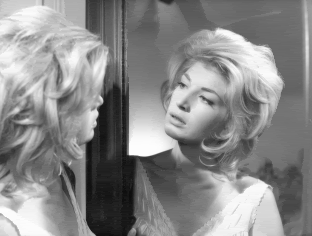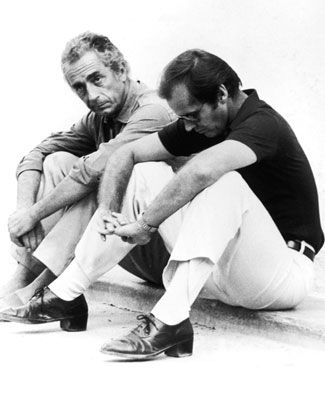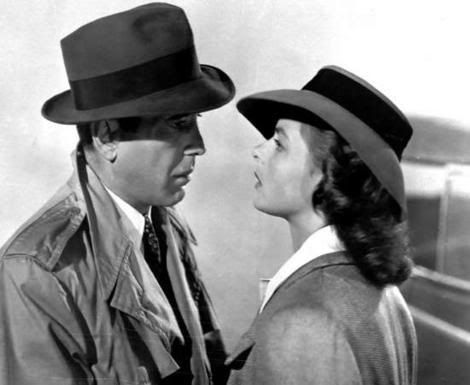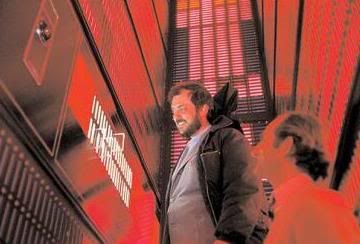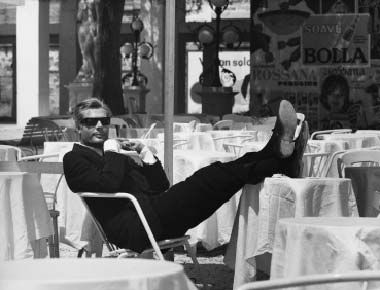
6-Winter Light. Director: Ingmar Bergman. Cast:Gunnar Björnstrand,Ingrid Thulin,Max Von Sydow and Gunnel Lindblom.
"no other director has done more with the human face"
-Roger Ebert-
-----
"One of the most important figures of the modern cinema, this phenomenally talented artist, through a series of films dating back to the 1940s, practically created and defined his own genre. Noted for pictures that probe the inner reaches of human emotion, Bergman has served as a model for generations of filmmakers around the world. His primary concerns are spiritual conflict and the fragility of the psyche; within these frameworks, he has crafted a body of work celebrated for its technical and textual innovation. Bergman's interest in life's enduring questions was undoubtedly fueled by a strict Lutheran upbringing (his father was chap lain to the Swedish royal family). As a child, Bergman displayed an active imagination and a love for the theater, which was also manifested during his training as an actor and director at the University of Stockholm."
-Leonard Maltin-
------
"On one level there are the general run of filmmakers who supply the public with good, solid entertainment year after year. Above them are the artists who make films that are deeper, more personal, more original, more exciting. And finally, above them all, there's Ingmar Bergman, who is probably the greatest film artist, all things considered, since the invention of the motion picture camera."
-Woody Allen-
-------
"Here is a difference between me and Bergman: for me God is not a mute. I totally disagree with those who claim an aura of films by the Swedish director is present in The Sacrifice. When Bergman speaks of God, he does it in the context of God who is silent, who is not with us. So we have nothing in common, just the opposite. Some of the superficial remarks were made because the actor in the main role had also worked with Bergman or because of the traces of Swedish landscape in my film. People making such claims have not understood anything in Bergman, they don't know what existentialism is. Bergman is closer to Kierkegaard than to problems of religion."
-Andrei Tarkovsky-
-------
"I think I have made just one picture that I really like, and that is 'Winter Light'. That is my only picture about which I feel that I have started here and ended there and that everything along the way has obeyed me. Everything is exactly as I wanted to have it, in every second of this picture. I couldn't make this picture today....but I saw it a few weeks ago together with a friend and I was very satisfied."
-Ingmar Bergman-
--------
"The shooting was extremely demanding, and dragged on for fifty-six days. It was one of the longest schedules I've had, and one of the shortest films I've ever made. For one thing, Gunnar Bjornstrand was ill all the time. That autumn, or in the summer I think it was, he'd had severe heart trouble and was in personal difficulties. Besides which he detested the role. The part really isn't a glamorous one, and he had a hell of a time; was forced to use other means of expression than he was used to. Throughout the filming Ingrid Thulin was a tower of strength. The role appealed to her; but she was a moral support, too. So was Gunnar, with his professionalism—always ready, at every moment. But it was a heavy job. I showed the film to my wife at that time [Kabi Laretei], and she said: 'Yes, Ingmar, it's a masterpiece; but it's a dreary masterpiece.' There's some truth in that; but the importance of the dreary in art mustn't be underestimated.
-Ingmar Bergman-
------
"Working in this profession of butchers and whores, you develop this great need to please people. You keep wishing your movies will be successful, that this strenuous effort you put into making a film...this Sisyphean task—you want people to approve of it, and you want houses to be sold out. Well, I was a bit tormented by all that. I felt I was being ingratiating. And so I thought to myself, 'I'm not going to worry about it. I'm not going to worry about being ingratiating. I will write strictly about the problems that occupy me. Not for a moment, not for a minute, do I want the story to be ingratiating. I'll tell the story exactly and precisely the way I envisioned it.' We maintained this very strict form. Which meant that all the light...would be this grayish, shadowless light. November light. Sven and I went up to Dalarna, to a church in Skattungbyn, where we sat from morning till night taking notes. Sven took pictures the whole time of how the light moved through the church. He then invented something that had never existed before, a kind of lamp that could provide a shadowless light. I'm very fond of this movie. I think in a way this is the movie that is closest to me. Because for once I made a film that I consider a brave film."
-Ingmar Bergman-
